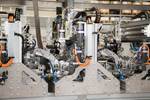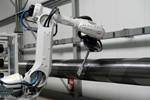Loop Technology completes installation of composite preformer with long-reach robots
Delivery of 21-meter track, industrial robot arms and new cutting equipment enable the manufacture of large composite aerostructures at the Loop Technology Centre.
Loop Technology (Dorchester, U.K.) has announced the construction of its latest FibreLine system — an end-to-end automated composite preforming for smaller parts and components — at the Loop Technology Centre. This particular configuration offers a material deposition rate of up to 200 kilograms/hour. Its high rate facilitates a wide range of advantages from streamlining downstream assembly to reducing factory footprint.
The company achieved its installation with the delivery of a 21-meter Güdel (Langenthal, Switzerland) TrackMotion Floor-6 (TMF-6), which can move robots weighing up to 6 tons, in April this year, a new Zünd (Altstättden, Switzerland) cutting table, the building of FibreForm — Loop Technology’s 3D composite pick-and-place end effector that is central to FibreLine — and delivery of two FANUC (Rochester Hills, Mich., U.S.) M-2000iAs, the 1700L and 900L, in May.
On May 17th, the M2000ia 1700L was the first to arrive, weighing 12.5 tonnes, with almost 4.7 meters of reach and a 1.7-tonne payload capacity. The 900L was installed second — it offers the same reach as the 1700L with a payload capacity of 900 kilograms.
Both robots provide the capability needed for FibreLine, particularly FibreForm. According to Loop Technology, the composite aerostructures that will be manufactured with the FibreLine system are large and require highly flexible, long-reach robots. Mounted on the TMF-6 track, they will reportedly enable unfettered access to the cell area in order to perform necessary inspection and deposition activities.
Loop Technology developed the timelapse video below of FibreLine’s installation.
Related Content
-
Cryo-compressed hydrogen, the best solution for storage and refueling stations?
Cryomotive’s CRYOGAS solution claims the highest storage density, lowest refueling cost and widest operating range without H2 losses while using one-fifth the carbon fiber required in compressed gas tanks.
-
Combining multifunctional thermoplastic composites, additive manufacturing for next-gen airframe structures
The DOMMINIO project combines AFP with 3D printed gyroid cores, embedded SHM sensors and smart materials for induction-driven disassembly of parts at end of life.
-
Manufacturing the MFFD thermoplastic composite fuselage
Demonstrator’s upper, lower shells and assembly prove materials and new processes for lighter, cheaper and more sustainable high-rate future aircraft.

















